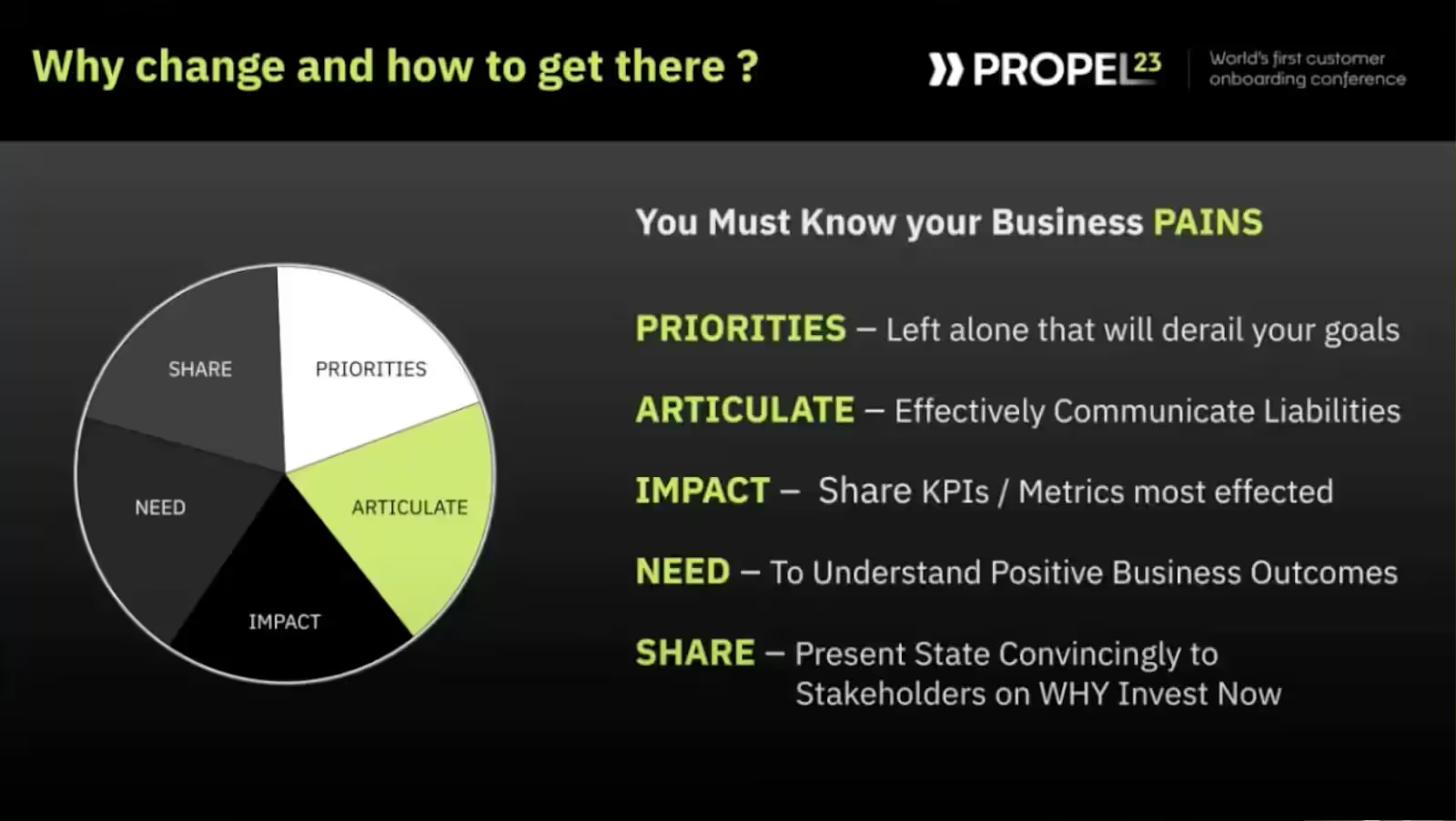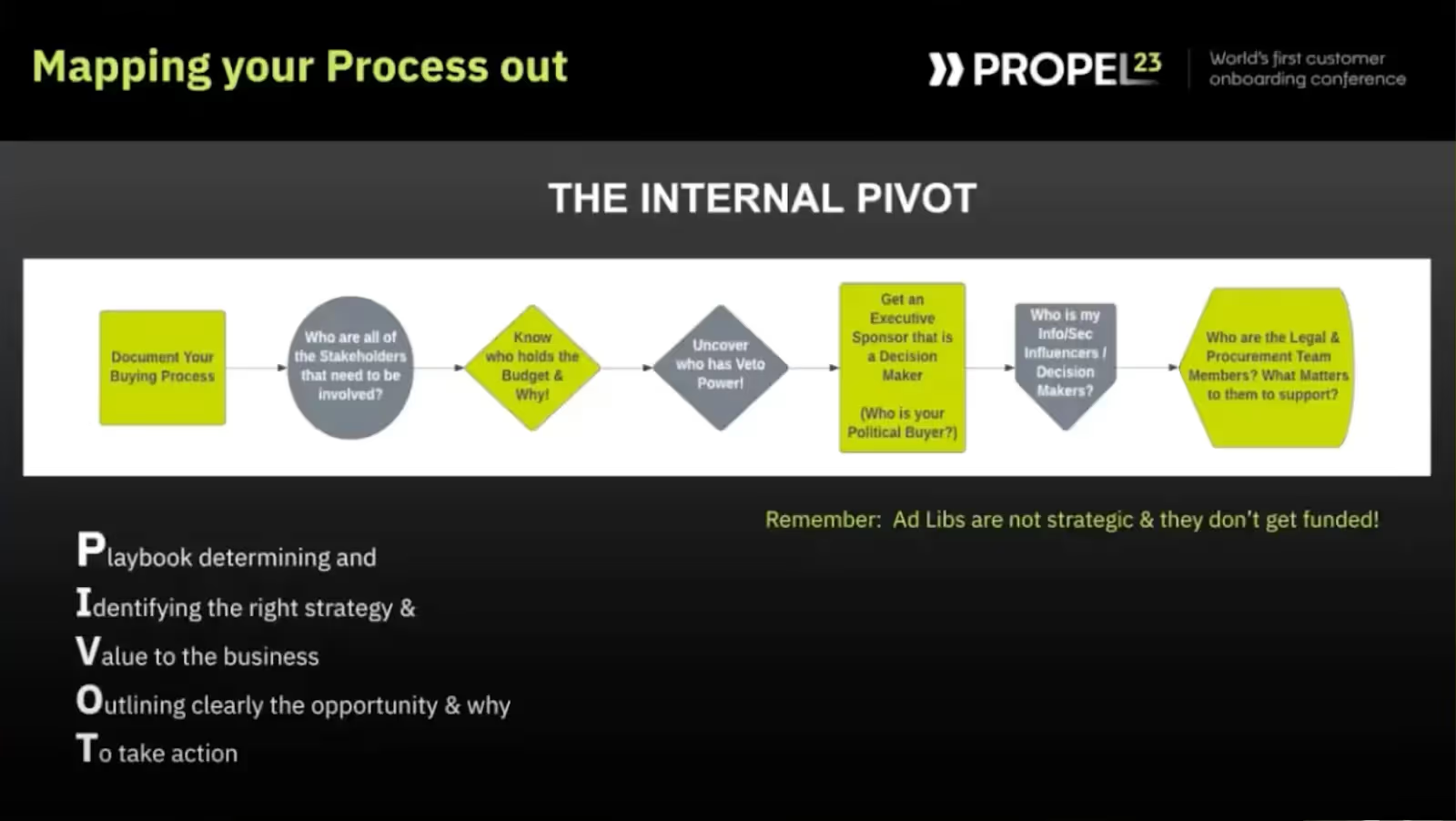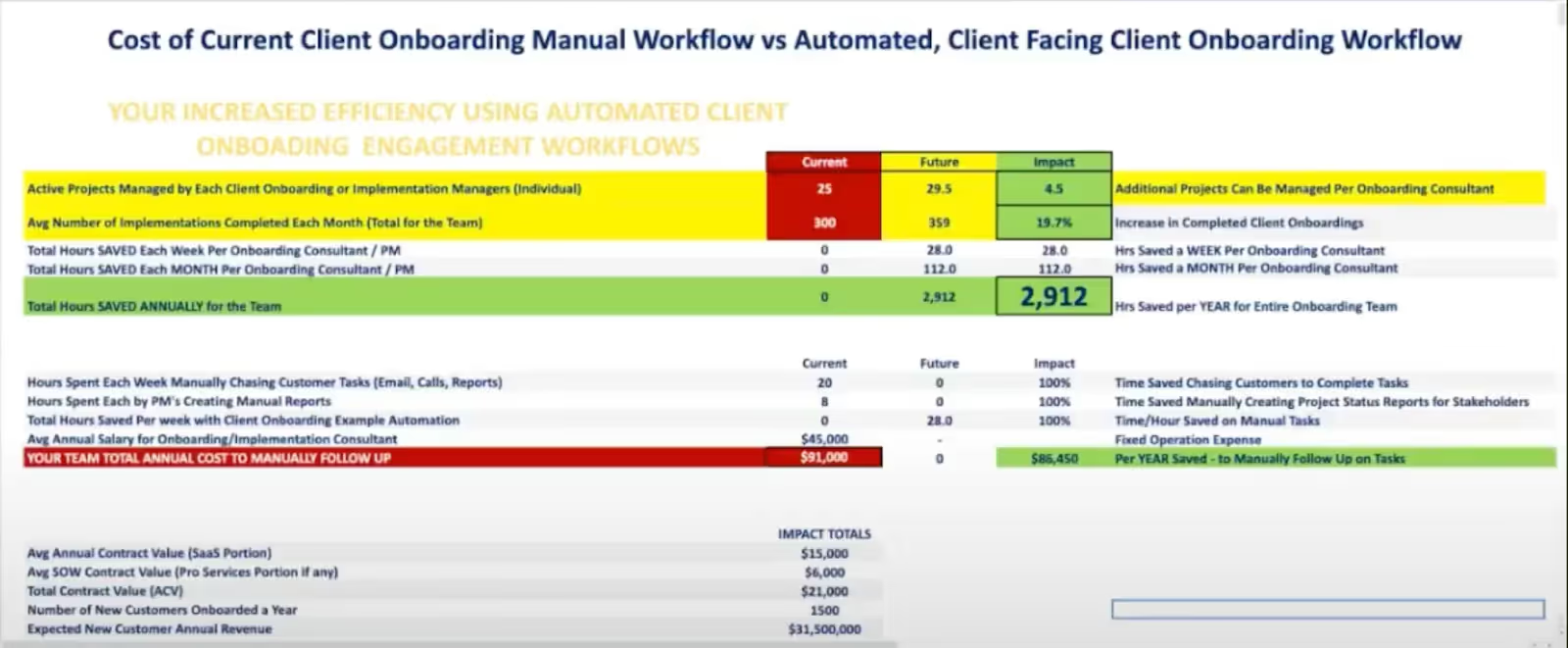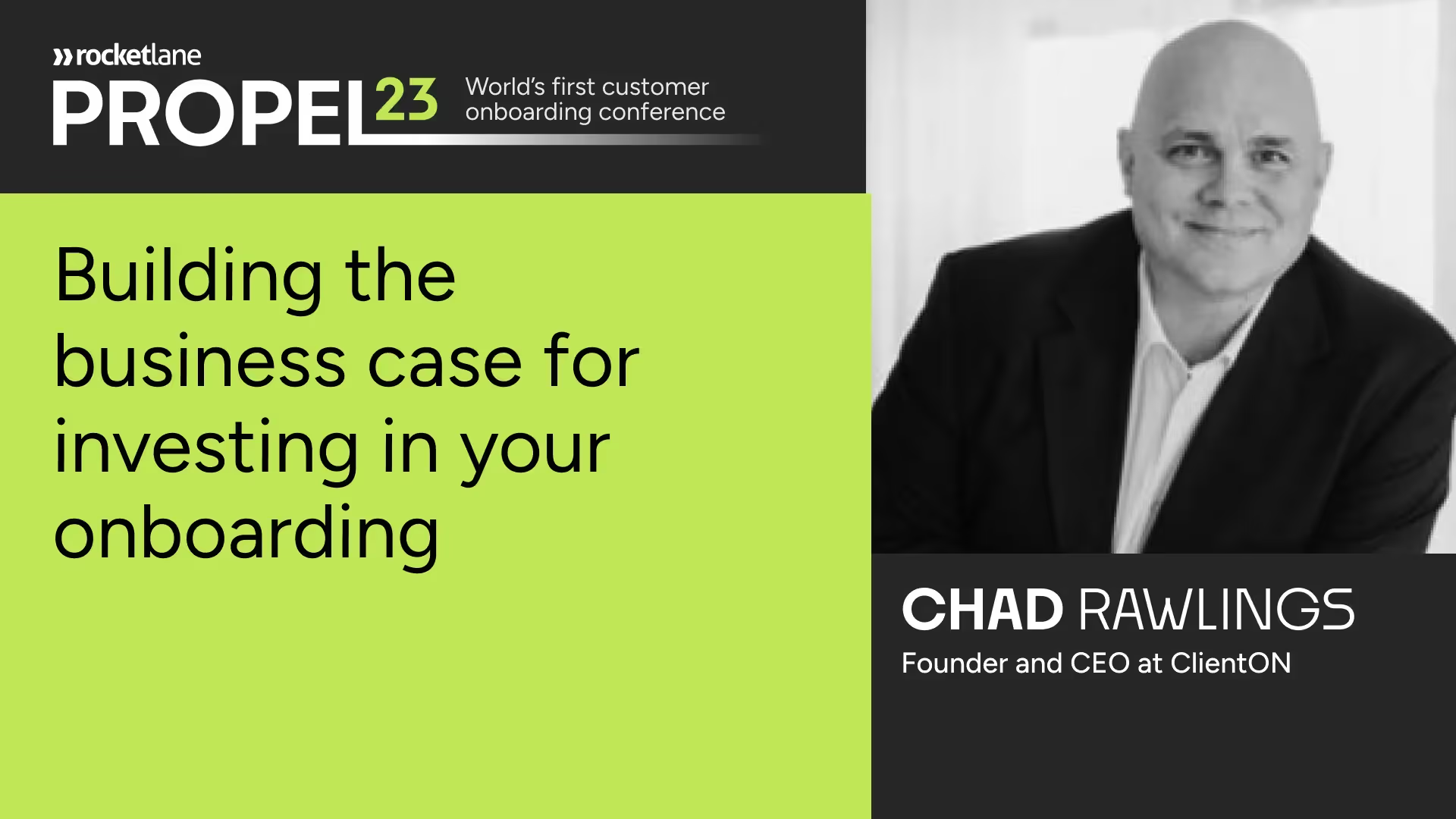Further reading
- Check out The State of Customer Onboarding 2023 report to learn the latest trends and common challenges in the customer onboarding space
- You might also want to look at this discussion by C-Suite executives on why you should invest in customer onboarding
- Check out these internal metrics to track for customer onboarding teams that you can use to make your onboarding teams and processes more efficient
Chad Rawlings is the Founder and CEO of ClientOn, and a passionate Success and Sales leader, consultant, and speaker. Chad is also a veteran of successful radio spots, TV commercials, SKO appearances, podcasts, webinars, and thousands of Sales and Success presentations or training sessions. He’s currently an author in the making.
In his session for Propel23, Chad spoke on the importance of investing in onboarding, especially when there are tighter budgets and strict scrutiny from CFOs. He shared insights on engaging enterprise, mid-market, and SMB companies through strategic conversations and timely approaches. He also offered ideas on securing funding, fostering innovative thinking, initiating discussions for internal buy-in, and implementing actionable solutions for positive change.
The race to efficient client onboarding
Chad started with an analogy: Consider two identical runners, one ahead of the other. Now, let's apply this to your company. Imagine running a race for a designated client onboarding period, whether 30, 60, or 90 days, depending on your typical scenario. In this specific scenario, the aim is to clone your finest implementation manager or CSM and see if they can surpass the other person in pursuing time-to-value, following the same three-month customer onboarding timeline. Select your top-performing individual and replicate them in every aspect, including their biases, habits, tendencies, personalities, and skill sets.
Let’s say one of them will rely on the current processes, such as spreadsheets or project management tools that lack client-facing technology. The other person will leverage client-facing technology specifically designed for client onboarding, ensuring automation, transparency, accountability, and the ability to complete tasks directly from their inbox.
No prizes for guessing who will achieve time-to-value faster.
The critical question, however, is how to effectively communicate this internally so it resonates with stakeholders who hold budgets and personal agendas and play various roles within the process. We must understand how to convey this message to ensure its impact.
Leveraging statistics to support your case to invest in client onboarding
By ensuring the initial service is executed flawlessly, businesses can decrease customer churn by up to 67%. Emphasizing customer solutions during this initial interaction is particularly impactful. It's common knowledge that the financial implications of churn are substantial, with every dollar lost in churn having a valuation impact of seven to ten times. Consequently, client onboarding significantly influences various crucial aspects, which we will discuss today.
You can use some key data points to assist you in presenting a compelling case for implementing effective client onboarding. An article in Forbes magazine estimated that churn costs the US alone a staggering $136 billion annually. Furthermore, 90% of customers believe that companies can improve their onboarding processes, while 78% have improved customer experience and shortening time-to-value as the focus in 2023. This signifies that businesses not prioritizing client onboarding can leverage these findings to engage key stakeholders.
Although these statistics offer invaluable insights, presenting a comprehensive business case outlining the positive outcomes of adopting effective client onboarding practices is vital.
Know your PAINS

Improving your company's overall success and achieving successful client onboarding hinges on a thorough understanding and effective addressing of its PAINS (Priorities, Articulate, Impact, Need, Share).
Priorities: The first step is identifying priorities that, if left unaddressed, could hinder achieving the company’s client onboarding goals. These priorities are crucial to focus on and tackle head-on.
Articulate: Once the priorities are identified, it is essential to communicate the associated risks and liabilities to stakeholders effectively. Clear articulation helps everyone understand the potential challenges that may arise.
Impact: Sharing key performance indicators (KPIs) and metrics that will be most affected by these risks is vital. The significance of addressing these priorities can be emphasized by highlighting the potential impact on KPIs.
Need: Stakeholders must understand the pressing need for change. A sense of urgency can be created by showcasing the potential positive business outcomes resulting from addressing these priorities.
Share: This information must be communicated convincingly to gain support and onboarding investment from stakeholders. Sharing the data and insights in a compelling manner will make stakeholders more inclined to take action.
We can ensure that goals are achieved by prioritizing, articulating impact, sharing the need, and effectively communicating internally.
Bridging the gap between the current and future states
Share and present the desired outcomes, gaps, and positive business outcomes for client onboarding. This includes the following:
- Increased efficiencies for both internal teams and clients
- Reduction of operational costs on manual tasks and reporting
- Decreased time-to-value and time-to-revenue
- Reduction of churn rate
- Increased customer satisfaction (CSAT) and Net Promoter Scores (NPS)
- Increased Net Revenue Retention (NRR)
- Increased company valuation
- Reduced cost of client onboarding workflows
- Enhanced visibility into resource management
- Effective tracking of project profitability through time tracking
To effectively communicate the importance of these goals, it's crucial to clearly articulate the current state of each area and the desired future state. This allows key stakeholders to understand the existing business model and recognize any existing pain points that may not be apparent. It's important to convey the critical nature of addressing these gaps, even if they are already well-known, especially when seeking funding for initiatives. By understanding the gaps, strategic efforts can be made to close them and showcase the positive impact of achieving the future state.
Mapping your process out with an internal PIVOT

It’s important to establish an internal PIVOT - a Playbook that determines and Identifies the right strategy and Value for the business, Outlining clearly the opportunity and why to Take action.
A clear outline should be provided, highlighting the opportunity and rationale for taking action. Identifying key figures such as the veto power, budget holder, and decision maker is essential, as they play a pivotal role in achieving the desired results. The importance of securing an executive sponsor cannot be overstated when meeting critical business needs. Holding conversations with these individuals ensures they fully understand the challenges and are motivated to invest in client onboarding. This onboarding investment can yield benefits across various domains, including reducing churn, enhancing net revenue retention, boosting customer satisfaction scores (CSAT), and increasing Net Promoter Scores (NPS). Time-to-value and time-to-revenue are particularly critical for Professional Services groups that receive payment upon project completion, as it directly impacts the bottom line.
Understanding stakeholder dynamics is indispensable when approaching them. Recognizing their personality types enables effective communication and mutually beneficial interactions. Building positive experiences for stakeholders in this process helps earn their belief in the shared vision, leading to decisive actions and favorable outcomes for both the company and its customers.
Calculator for measuring the impact of an automated client-facing client onboarding workflow

Chad then showcased a workflow he’d built for a client to convince them to invest in onboarding.
The current state, future state, and potential impact were thoroughly examined during the assessment process. By implementing automation in the client onboarding workflows, the results were impressive. The number of projects handled by each representative increased by nearly five projects per month, totaling 359 projects. This notable increase, approximately 20%, was achieved without increasing the headcount.
It was discovered that the representatives spent around 20 hours per week chasing down customers, resulting in significant expenses. A closer analysis revealed that the company was spending $91,000 annually on this time-consuming activity. By automating the solution, approximately 2900 hours were saved, which equated to that amount.
This significant improvement had a ripple effect on other aspects of the organization, such as SaaS and Professional Services contracts. By reducing the client onboarding process from 60 to 30 days, the company gained an additional $10,000 per day from each of the 25 clients per representative, totaling over $3.1 million annually.
Considering the cost of a typical SaaS solution ranges from $9,000 to $12,000 for a small team, the investment required for automation is minimal. The return on the onboarding investment is evident, as the cost savings far outweigh the initial investment, benefiting the organization as a whole.
Measuring and quantifying the trust created by better client onboarding
When engaging in business relationships, the endurance of customer loyalty becomes a crucial indicator of trustworthiness. Assessing the churn rate provides insights into the level of trust formed. Examining figures such as NRR can serve as a reliable indicator of successfully cultivating trust. Additional factors such as CSAT and NPS scores can be considered to evaluate trust comprehensively. Trust can thus be quantified through multiple avenues of measurement.
Effective strategies for utilizing customer usage metrics in PIVOT
When evaluating adoption rates and user engagement, stakeholders often face challenges. Manual tracking is inadequate for accurately quantifying customer adoption and generating automated reports that provide insights into customer behavior. Client onboarding tools can assist in quantifying metrics such as project completion rates, timely task execution, customer engagement, and product adoption. It enables organizations to assess the extent to which customers derive value from the tool from the start and continually monitor and monetize their progress.
Tools that track CSAT scores and customer learning progress are valuable for measuring and quantifying customer value. To assess these tools, enquiring about the tool’s adoption rates, license usage, average duration of tool usage, and daily engagement is important. These statistics are vital for effectively communicating with stakeholders and highlighting areas for improvement in adoption rates.
Strategies to convince CFOs to invest in client onboarding
When conversing with a CFO, it is essential to identify their top priorities. Start by posing a relevant question that addresses the impact of client onboarding on important metrics such as churn rate, NRR, and expansion. Inquire about any existing deficiencies and the potential liability for the organization if these issues are not addressed promptly. Lastly, emphasize the significance of KPIs most affected by the concerns. By approaching the discussion from this angle, you will quickly uncover pain points and align with the CFO's focus on financial outcomes. It is crucial to recognize that financial decisions are influenced by addressing pain points, as money typically flows toward resolving these issues.



















